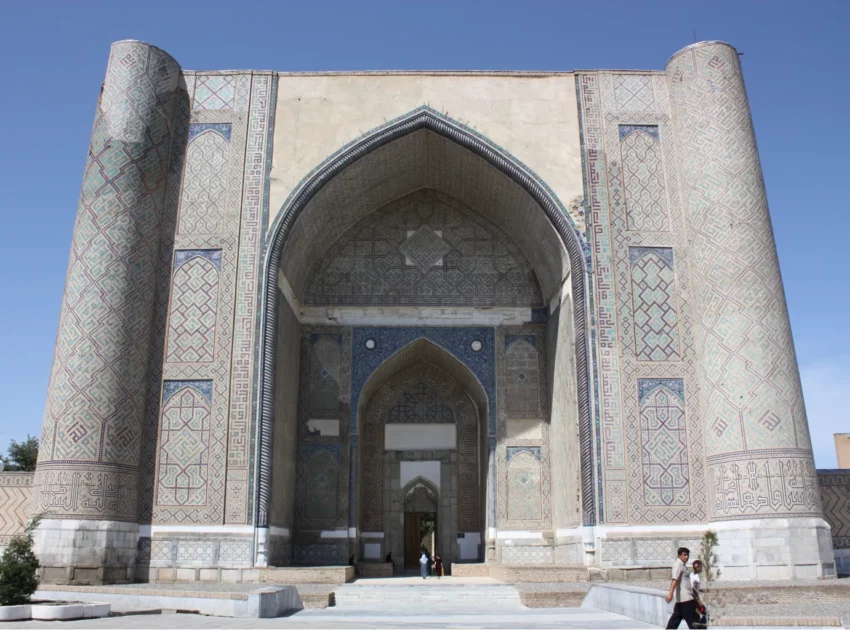Get your dose of History via Email
The Historical Context of the Bibi-Khanym Mosque
In the grand historical narrative, the Bibi-Khanym Mosque stands as a significant architectural marvel from the Timurid Empire, which reigned from 1370 to 1405 AD. Located in Samarkand, present-day Uzbekistan, this mosque was one of the most ambitious architectural undertakings in the Islamic world, reflecting the grandeur of its patron, Timur, also known as Tamerlane. Despite its current dilapidated state, the remaining structures still offer a window into the grandiosity that characterized Timur’s rule.
Architectural Significance and Design
As a pinnacle of architectural excellence, the Bibi-Khanym Mosque was designed to surpass all other structures in the Muslim world in both size and splendor. After Timur returned from his military campaign in India in 1399 AD, he commissioned the construction of the mosque, dedicating it to his favorite wife, Saray Mulk Khanum. Its design was the product of architects and craftsmen from across the empire who incorporated elements from various regions, creating a monumental complex that included a mosque, a Quran school, and a bazaar.
Construction and Grandeur
The building process relied on the extensive use of baked bricks and glaze-covered bricks — materials characteristic of Timurid construction. Around 600 workers toiled on the site, which was completed between 1404 and 1414 AD. According to historical accounts, the mosque’s main dome was flanked by four minarets, each with a height of around 40-50 meters, making them some of the tallest in the Muslim world at the time.
Decline and Damage
Unfortunately, the ambition that birthed the Bibi-Khanym Mosque also contributed to its early structural issues. By the late 16th century, the edifice had fallen into disrepair due to material deterioration and seismic activity, which is prevalent in the region. Subsequent damage occurred in the 18th century, reducing much of the mosque to ruins. It was not until the 20th century that any conservation work began, aimed initially at preventing further collapse rather than undertaking full restoration.
Modern Restoration Efforts
Historical conservationists are confronted with the challenge of preserving the remaining authentic attributes of such sites while enabling meaningful access and interaction. The Soviet Union, recognizing the historical value of the Bibi-Khanym Mosque, initiated a series of restorations, which were carried on sporadically from the 1970s to the present day. These efforts have highlighted the mosque as a prominent tourist attraction and an essential part of Samarkand’s UNESCO World Heritage Site designation.
Contemporary Relevance and Use
Today, the mosque still serves as a place of worship, particularly during the Muslim holiday of Eid al-Adha. Its grandeur and historical significance make it a primary artistic and cultural representation of the Timurid Empire. Despite suffering extensive damage over the centuries, the structures that survived, such as the main portal, the mosque walls, and part of the entrance arch, continue to exhibit the traditional Timurid architectural styles. Their blue-and-white tiled facades continue to captivate visitors with their intricate details, embodying a historical narrative that spans over 600 years.
Historical Reinterpretations and Narratives
The Bibi-Khanym Mosque’s legendary status has been further immortalized through various historical tales and narratives. One such legend claims that the mosque was named after Timur’s beloved wife, who had the mosque constructed while he was away. Another story involves the architect falling in love with Saray Mulk Khanum, with different endings depending on the version. Though these narratives may not fully align with factual history, they contribute to the mosque’s mystique and cultural significance.
Conclusion
As an enduring symbol of the Timurid Empire’s might, the Bibi-Khanym Mosque offers invaluable insight into the era’s architectural trends, building techniques, and aesthetic preferences. Despite periods of neglect and damage, the mosque’s remnants eloquently speak to its past splendor and significance. Through ongoing preservation efforts, the mosque continues to be an important cultural and religious landmark, bridging the historical and contemporary in Uzbekistan’s vibrant cultural landscape.
Sources: Wikipedia

